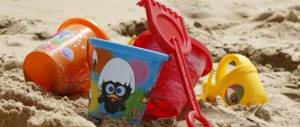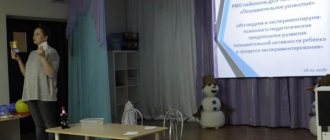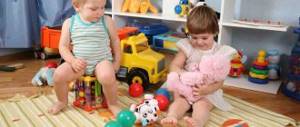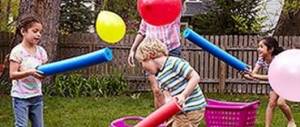It is no secret that early age plays a special role in the intellectual development of a child. A primary image of the world is formed, the child begins to realize himself and his place in it. The child’s first human qualities are taking shape, which in the future will become the foundation of his character.
The perception of the surrounding world in the early and early preschool period becomes more subjective - the child begins to experience feelings for objects and phenomena that allow him to separate the beautiful from the ugly, the interesting from the uninteresting.
Interest in learning is a distinctive feature of young children
Considering the increased sensitivity of the child’s psyche to external influences on him and the good quality of assimilation of new knowledge, skills, abilities, it is important to pay attention to various aspects of his development, including intellectual. Shortcomings at this stage can have an extremely negative impact on its development in the future.
What types of activities at this age should be developed first and what should we pay special attention to? Let us consider the patterns of development of cognitive development of a young child.
Cognitive development of children - structure and features
Neoplasms of early age
The development of active cognitive activity in children of early and early preschool age is marked by the following changes occurring in the structure of the child’s personality.
- Formation and development of self-awareness . The child begins to gradually separate himself from the world around him. He develops such qualities as independence, curiosity, and interest in the world around him. He is interested in everything that happens around him and what surrounds him in particular.
- Basic trust in the world around you . It develops in the process of the child’s interaction with people around him and the acquisition of his first positive experience.
- Determination . The child learns to direct his activities and structure them to achieve his own goals. Children form an understanding of what specific actions need to be performed to obtain a particular result and make their first attempts to follow one or another instruction. Purposefulness gives the child the opportunity to understand the meaning of cognitive activity and complete what he starts. By the beginning of preschool age, this quality must be formed.
- Creative activity . Gaining experience in interacting with the world around him, the child begins to gradually transform it, manipulating and experimenting with its content. Therefore, it is important to encourage his participation in creative activities in any form.
Features of development of young children
Features of cognitive development
In children of early and primary preschool age they look like this:
Of all the processes of cognitive development in early childhood, perception is the dominant one.
It is most well developed, but at the same time it is still involuntary. The imperfection of perception lies in the fact that the child is able to grasp only individual qualities and properties of certain objects and still inextricably connects them with the conditions in which he finds himself.
Perception is the main way children develop
The imagination of children under preschool age is rather poorly developed and manifests itself mainly in the form of anticipation of the possible results of a particular action. Creative imagination does not yet make itself felt. A positive feature of this feature is the inability to lie, which will make itself known a little later.
Children remember involuntarily. Only objects that are distinguished by novelty, brightness, contrast, etc. are stored in the child’s memory. For successful cognitive development, it is necessary to gradually accustom him to purposeful memorization, the task of separating what is significant for him from what is less important.
The predominant form of thinking is visual and effective. The child will acquire knowledge about objects through direct interaction with them.
Basics of sensory development of younger preschoolers
By about six months, the child develops autonomous speech, which subsequently disappears and is replaced by more familiar, “adult” words. The volume of vocabulary grows: by the first year of life it is 10 words, by one year and eight months it is already 100, at two years this figure increases to 300, and by three years it approaches 1000 - 1500.
By the age of one and a half years, the child acquires the ability to speak not in separate words, but already put them into sentences. Their features are such that for now they are quite short and consist of 2-3 words.
Speech development in preschoolers - diagram
The child begins to speak more common sentences closer to the third year. And although the speech of children is not always understandable to adults, they most often manage to convey to them what exactly they need at a particular moment. By the beginning of preschool age, the child already has fairly coherent speech.
Development of perception
Perception is the leading mental process in the development of cognitive activity of a young child. Perception is a system for a person to reflect manifestations of the surrounding world through their influence on the senses. It is perception that determines the consciousness and behavior of children. Memory, thinking and attention are entirely related to perception: the child recognizes the objects that he perceives, establishes connections between them, and perceives those objects that fall into the area of his attention. The baby’s experiences also depend on the perception of actions and phenomena.
“In order to correctly navigate the environment, it is important to learn to correctly perceive both individual objects and as a whole.”
The simplest forms of perception are formed in infancy: the baby develops conditioned reflexes as a reaction to stimuli. A child of primary preschool age identifies attractive and bright objects, something unusual, moving, to which he responds emotionally.
The formation of perception is a complex process that requires special attention, which is aimed at helping the baby navigate the world more easily, be able to distinguish the subtlest aspects of the surrounding reality, and adapt faster.
With the help of games and exercises, you can direct the formation of perception in the right direction:
- "To the touch". Place several simple objects in a small opaque bag: buttons, cubes, candy, pencil, etc. Invite your child to guess by touch what these objects are.
- "Repeat". Make a tower out of cubes. Ask your child to repeat the construction exactly. This exercise can be done in the form of drawing: draw a pattern, ask to draw the same one.
- “Pick up the same item.” Prepare several different drawings of a table lamp (or other object. Let the child find two identical drawings.
Watch a video about the development of speech and perception in babies
Goals of cognitive development
The tasks of cognitive development of children at the early age stage are as follows:
- Creating an environment conducive to the child’s intellectual development. The child should be provided with conditions conducive to comfortable play and interaction with family members and peers.
- Developing a child’s interest in the world around him and the events taking place in it. It is necessary to encourage the child to pay attention to what is happening around him, especially to share his impressions with his parents.
- Development in a young child of abilities for active creative activity, various operations with objects. He should have materials for creativity at his disposal.
- Expanding the conceptual apparatus and ideas about the world around us. To do this, it is very important to communicate with your child on simple topics that are accessible to his age. It is also advisable to watch educational programs and watch educational television programs.
- Developing an understanding of cause-and-effect relationships and factors that explain events occurring around us. Answers to all kinds of children's “whys” greatly contribute to this. It is important to take any questions seriously, no matter how illogical they may seem.
- Creating conditions that encourage the child to demonstrate independent active activity. It is better to allow the child to do this or that action on his own, even if not the first time and in the best way, than to deprive him of the opportunity to take the initiative.
- Formation of a friendly attitude towards people and the surrounding world in general. A young child is still poorly acquainted with the rules of etiquette, but it is already important that he can build basic relationships with others, including peers, master communication skills, etc.
Model of a developmental environment for children 2-3 years old
Environmental education of young children (presentation)
1 slide
Topic: Environmental education of early preschool children
2 slide
Environmental education is a complex pedagogical process. It forms a system of a person’s relationship to himself from the position of his relationship to nature.
Early age is the most favorable time for sensory education, for accumulating ideas about the world around us. Since at this age children are constantly in contact with nature and their first sensations are connected precisely with the components of nature: light and darkness, the Sun and Moon in the sky, heat and cold, weather phenomena - wind, precipitation, sounds, colors, the shape of natural objects, life manifestations of various organisms that invade the child’s world every minute.
It is necessary to teach children to love and take care of nature from a very early age, because at this age children are interested in everything around them, they listen carefully and remember the information conveyed.
We give children the concept that both plants and animals are living beings, they breathe, drink water, grow, and most importantly, feel pain, like people. A broken branch cries and asks for help, the torn leaves will die, cats or dogs may scratch or bite if you hurt them. We teach them to take care of wildlife and the rules of behavior in nature. We explain why it is necessary to protect and care for the environment and clean up trash after yourself. But at the same time, we ourselves must serve as an example for the child.
3 slide
I set the following tasks: to lay down the first elementary ideas and guidelines in the natural world; promote the development of children's cognitive and speech skills; to cultivate in children a humane and aesthetic attitude towards nature.
4 slide
One of the most important conditions for the implementation of the tasks of environmental education for children is the correct organization of a subject-development environment. The ecologically subject-developing environment of our group’s corner of nature includes: indoor plants, a weather calendar, didactic and educational games of environmental content, a table for playing with sand and water, kinetic sand, objects for playing with water and sand, various natural materials for games and experimental – experimental activities.
5 slide
Nurturing children's correct attitude towards nature and the ability to carefully handle living beings can be fully realized through the interaction of kindergarten and family. The kindergarten carries out systematic work on environmental education, including work with the family. Various stands are set up for parents with information about raising children’s environmental culture, parent meetings on the topic are held, conversations are held, requests for help in designing and enriching the subject-development environment, participation in winter construction projects and competitions. Tasks for joint work between parents and children at home and on the street.
6 slide
What methods of introducing a child to nature are most effective? First of all, constant, repeated observations of animals, plants, objects and inanimate natural phenomena in combination with games, search activities, reading children's books, nursery rhymes, musical activities, and experimental activities.
Kids understand everything literally and retain their feelings for a long time, and if they are emotionally charged, then for the rest of their lives. The correct attitude towards living beings and nature is the end result, and it is brought up in joint activities and games with adults. Such activities are most effective if they evoke positive emotions in children, if they actively perceive everything that the teacher says and does.
Our main task is to enrich the child’s world with vivid impressions of the diversity and beauty of natural phenomena.
We must build our work on environmental education taking into account the age characteristics of young children. First of all, we must interest the child. Therefore, we start with what we can see and touch (water, stones, shells, sand, twigs, indoor plants). And with the help of music with the sounds of nature, we can give children the opportunity to feel all the beauty and kindness of nature.
From early childhood, children explore the world around them and are drawn to the beautiful and bright.
Such activities create the prerequisites for revealing the child’s emotional potential and cultivating basic environmental consciousness.
7 slide
To diversify and make activities more interesting, you can conduct various experiments, experiments and observations with children (for example, Games with sand - pour from palm to palm, from a scoop to a mold, bury various objects in it and dig them out, build slides, paths and draw ).
8 slide
Games with water - pour, filter through a sieve, pour through watering cans, through straws, make fountains, games with a water mill).
Water helps children better study the properties of objects: light-heavy, sink-float
Slide 9
Children also study the properties of water, snow and ice. Playing with water and sand is a great help during the adaptation period, since water and sand have relaxing properties, which means they calm and relieve nervous tension. While playing, children develop their imagination and sensorimotor abilities, as well as fine motor skills.
Therefore, children's experimentation can be considered as the main activity in understanding the world around them during preschool childhood.
10 slide
Indoor plants are the closest to children. It is very important to interest the child so that he has a desire to participate in research and perform various tasks. For example, when caring for indoor plants, you can offer children various activities: loosen the soil, wipe off dust from leaves, and water the plants. Each child will choose an activity to their liking with great pleasure and complete it with enthusiasm. In the process of work, it is necessary to say that thanks to our care for plants, they grow so bright and beautiful, but if we stop caring for them, they may die. At a young age, children are very emotional and receptive; they begin to sympathize with the plant and report problems they notice, or, on the contrary, rejoice at the blooming flowers.
So, a small child’s acquaintance with the green kingdom forms the first aesthetic ideas about the life of “green friends”, promotes the development of observation and interest, and fosters a caring attitude towards plants.
11 slide
Observations are also carried out on the territory of the kindergarten. Children become acquainted with and gain basic understanding of trees and plants (root, trunk, stem, branches, leaves, flowers, seeds).
During the research process, it is necessary to use all senses: vision, smell, hearing, and touch. It is important to develop and support children’s emotional relationship with nature. In the process of studying a tree that the child had not previously paid attention to, he discovers many unexpected and new things. It turns out that a tree can be different in different weather conditions; at different times of the year it is home to many inhabitants (insects, birds).
When introducing children to wintering and migratory birds, they gain a basic understanding of birds (beak, wings, tail, feathers, fly, peck). They learn what they eat, that winter is a very difficult period for birds: there is little food, no insects, it’s cold, so they need to be fed.
12 slide
The success of environmental education of children 2-3 years old is ensured by an understanding of psychophysiological characteristics. Environmental education is carried out using various methods and forms of work. The teacher provides environmental education to young children using didactic games with toys depicting animals, with pictures, including play exercises and play-based learning situations. Thanks to the game, the child learns new information about the natural world, develops memory and perception, talks about the life of animals and plants, and develops thinking and speech.
Environmental education of children is an important link in preschool education; it is during preschool age that emotional impressions about nature and society are formed, ideas about different forms of life are accumulated, and the basis of environmental thinking, consciousness and culture is formed.
Slide 13
THANK YOU FOR YOUR ATTENTION!
Principles of child intellectual development. Useful tips
Taking into account the individual characteristics of the child in the process of activity is a prerequisite for the proper development of the child. Despite the fact that each age period should be marked by a transition to a new stage of development, they should not be neglected.
Features of memory development in young children
The tasks offered to a child of early (preschool) age must necessarily correspond to his level of development, take into account his characteristics and not cause excessive difficulties. However, we should not forget that the child will quickly lose interest in overly easy tasks. The correct choice of task complexity will directly affect the quality of development of his volitional qualities.
Regularity and systematicity of classes are conditions for the success of any activity, failure to comply with which will negate all their effectiveness.
Regularity of classes ensures uniform and complete development.
It is much better to conduct regular short-term classes than to devote them to one day a week.
The child's attitude towards classes should remain positive. The tasks should be interesting to him.
The child’s independence must also remain an indispensable condition for activities aimed at his learning and development.
The cognitive development of children of early and early preschool age is subject to similar patterns. Knowing them, you can help your child easily prepare for later life.







